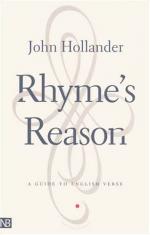|
This section contains 824 words (approx. 3 pages at 400 words per page) |

|
Variation and Mimesis, More on Rhyming and Uncommon Schemes Summary and Analysis
Sticking too close to a fixed rhythm or accent pattern can make verse boring and sound like the relentless ticking of a clock, Hollander explains. Adding variation can prevent the verse from becoming too predictable and make it more enjoyable. Variation can be employed using many of the methods described earlier by Hollander, such as by using caesura and enjambment to break lines up in varying ways and introducing small variations in the meter to hold the reader's interest.
Mimesis is a term that refers to the imitative sounds found in verse where the words make reference to their own meaning. As an example, Hollander quotes from Shakespeare, "When you do dance, I wish you / A wave o' the sea, that you might ever do...
(read more from the Variation and Mimesis, More on Rhyming and Uncommon Schemes Summary)
|
This section contains 824 words (approx. 3 pages at 400 words per page) |

|




